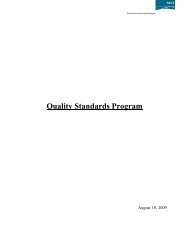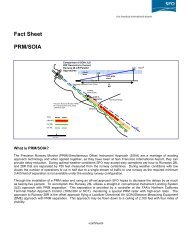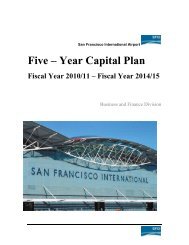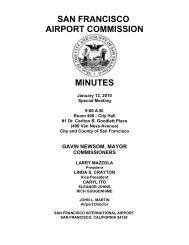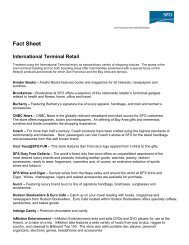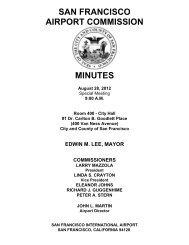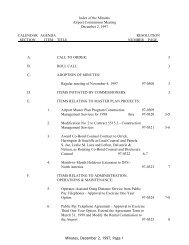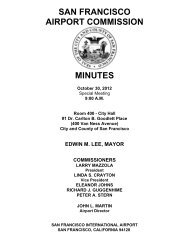Official Statement Airport Commission City and County of San ...
Official Statement Airport Commission City and County of San ...
Official Statement Airport Commission City and County of San ...
Create successful ePaper yourself
Turn your PDF publications into a flip-book with our unique Google optimized e-Paper software.
Hazardous Material Management<br />
Environmental Control Unit<br />
The <strong>Commission</strong> has an Environmental Control Unit that is responsible for environmental compliance<br />
issues. This unit includes pr<strong>of</strong>essional engineers <strong>and</strong> chemists, sanitary technicians <strong>and</strong> inspectors <strong>and</strong> surveillance<br />
teams. This unit is supported by on-site consultants, on-site testing <strong>and</strong> treatment facilities, <strong>and</strong> an on-call<br />
environmental contractor to provide rapid clean up where contamination is unexpectedly encountered during<br />
construction or other activities.<br />
Remediation <strong>and</strong> Preventative Measures<br />
The <strong>Commission</strong> <strong>and</strong> certain <strong>Airport</strong> tenants have discovered <strong>and</strong> remediated or are engaged in the process<br />
<strong>of</strong> remediating <strong>and</strong> managing certain contamination on <strong>Airport</strong> property pursuant to current regulatory st<strong>and</strong>ards.<br />
The contamination has primarily consisted <strong>of</strong> fuel constituents which most likely resulted from fueling practices <strong>of</strong><br />
the 1940s through the early 1960s. Since then the <strong>Commission</strong> has instituted regulations which require fueling<br />
practices <strong>and</strong> facilities requirements that are less likely to contribute to hazardous environmental discharges. The<br />
<strong>Commission</strong> believes that the jet fueling system is currently in compliance with applicable environmental<br />
regulations.<br />
Remediation activities at the <strong>Airport</strong> in the majority <strong>of</strong> cases have consisted <strong>of</strong> removal <strong>and</strong> <strong>of</strong>fsite disposal<br />
<strong>of</strong> contaminated soil <strong>and</strong> extraction <strong>and</strong> treatment <strong>of</strong> contaminated groundwater <strong>and</strong> in-situ methods approved by the<br />
regulatory agencies with jurisdiction. Substantially all <strong>of</strong> the hazardous material management work for the Master<br />
Plan was completed within budget <strong>and</strong> on schedule.<br />
To avert the migration <strong>of</strong> contamination into environmentally sensitive areas such as the <strong>San</strong> Francisco<br />
Bay, the <strong>Commission</strong> has installed, <strong>and</strong> has future plans with its tenants to install, monitoring wells at various<br />
locations including the <strong>Airport</strong>’s outer perimeter. The monitoring wells have thus far detected very low levels <strong>of</strong><br />
contamination. Further investigation is being coordinated with the Regional Water Quality Control Board <strong>and</strong><br />
tenants to ensure that the contamination has no adverse impact on environmentally sensitive areas.<br />
Water Quality Control Plant<br />
The <strong>Commission</strong> owns <strong>and</strong> operates a water quality control plant (the “Plant”) located at the <strong>Airport</strong>. The<br />
Plant was designed with a dry weather capacity <strong>of</strong> 2.2 million gallons per day <strong>and</strong> is used to treat wastewater from<br />
various <strong>Airport</strong> facilities prior to discharge into the <strong>San</strong> Francisco Bay. In 2001, the California Regional Water<br />
Quality Control Board, <strong>San</strong> Francisco Region, issued a Cease <strong>and</strong> Desist Order requiring the <strong>Airport</strong> to comply with<br />
its wastewater discharge permit requirements by increasing the reliability <strong>of</strong> the Plant. In 2002 the <strong>Commission</strong><br />
awarded a contract for a three-year $37 million expansion project to improve the Plant. This project, which was<br />
completed <strong>and</strong> operational in 2004, exp<strong>and</strong>ed <strong>and</strong> upgraded the Plant to incorporate current wastewater treatment<br />
technology, increase dry weather capacity to 3.22 million gallons per day, <strong>and</strong> provide redundancy during peak<br />
dem<strong>and</strong> periods.<br />
CAPITAL PROJECTS AND PLANNING<br />
The <strong>Commission</strong> maintains capital plans (the “Capital Plans”) for budgeting <strong>and</strong> planning purposes. These<br />
plans are periodically updated by <strong>Airport</strong> staff <strong>and</strong> approved by the <strong>Commission</strong> based upon available funding<br />
sources, anticipated capital needs, airline feedback, <strong>and</strong> project priority. The FAA administers the <strong>Airport</strong><br />
Improvement Program (the “AIP”) <strong>and</strong> grants are made available to airport operators in the form <strong>of</strong> entitlement<br />
funds <strong>and</strong> discretionary funds. The majority <strong>of</strong> the grant funds received by the <strong>Commission</strong> are AIP grants.<br />
In Fiscal Year 2004-05, the <strong>Airport</strong> resumed preparation <strong>of</strong> an annual update to its multi-year Capital Plan,<br />
which had been suspended following the events <strong>of</strong> September 11, 2001. The most recent revision to the five-year<br />
Capital Plan corresponds to the period between Fiscal Year 2009-10 <strong>and</strong> Fiscal Year 2013-14. These revisions were<br />
approved by the <strong>Commission</strong> in February 2009, <strong>and</strong> resulted in a five-year Capital Plan that includes an aggregate <strong>of</strong><br />
64



